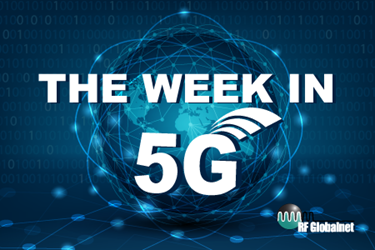The Week in 5G: 8/27/2019 — South Korea's KT Addresses 5G Device Battery Drain, Huawei Launches AI Processor and Computing Framework, Verizon Makes Deal To Bolster Its Indoor 5G
By Ed Biller

While the mmWave band has served Verizon’s 5G initiatives adequately outdoors, it has encountered performance issues indoors. In response, the carrier has partnered with Boingo Wireless to enhance its indoor wireless capabilities.
To that end, the two companies are collaborating on a “hyper-dense network” for indoor spaces – an initiative that The Verge speculates amounts to simply “offering branded Wi-Fi where it can offload 5G.”
The UK, following a failed mobile infrastructure project – it set aside £150 million and managed to “build” about 50 of a planned 600 sites, many of those on existing masts for things like broadcast radio and TV -- has launched a £30m competition to “Spark a tech revolution in countryside communities and help rural Britain seize the opportunities of 5G technology.”
The effort is spearheaded by the Right Honourable Nicky Morgan, Secretary of State for Digital, Culture, Media and Sport, who told Forbes that “The British countryside has always been a hotbed of pioneering industries and we’re making sure our rural communities aren’t left behind in the digital age. We’re investing millions so the whole country can grasp the opportunities and economic benefits of next generation 5G technology.”
When you think of successful 5G rollouts, you might think of the U.S. or South Korea or even China – perhaps Switzerland should be on your list. Two of that nation’s top three carriers -- Swisscom and Sunrise -- are offering commercial 5G services, and the third national operator, Salt, plans to launch later this year, reports RCR Wireless.
Add Vietnam to the list of countries who have rejected Huawei gear for “security concerns.” That nation’s top carrier, Viettel, has selected Ericsson, Nokia, and Qualcomm 5G components, and other carriers in the country of 96 million “appear to be following its lead,” reports VentureBeat.
Other countries in Southeast Asia, including Malaysia, the Philippines, and Thailand, all have signaled that Huawei gear would be welcome as part of their 5G rollouts.
None of this has stymied Huawei’s efforts to be at the forefront of 5G, though. This week, the Chinese telco launched its artificial intelligence (AI) processor, the Ascend 910, and an all-scenario AI computing framework, MindSpore.
The Ascend 910 is is part of Huawei’s series of Ascend-Max chipsets and is used for AI model training. “In a typical training session based on ResNet-50, the combination of Ascend 910 and MindSpore is about two times faster at training AI models than other mainstream training cards using TensorFlow,” reports RCR Wireless, citing the company.
The article states that the Ascend 910 will be available in China next month and in overseas markets in Q1 2020, while MindSpore will go open-source in January next year. Additionally, Huawei CEO and founder Ren Zhengfei said in a recent interview that the telco intends to ship more then 2 million 5G base stations over the next two years.
Duubee's has launched in the U.S. its first 5G commercial terminal. The device is based on a Qualcomm platform, according to a release form the company, and it represents one of several “Smart Home” products Duubee plans to launch in the U.S. market.
“The Duubee 5G CPE WG50 supports several different kinds of WAN and creates a 5GHz Wi-Fi network. With 5G network, a 1GB HD video can be downloaded in just about five seconds. 8K format videos can also be played smoothly, without interruption,” states the release, noting that the device achieves a peak 5G download rate over 2.33 Gbps, nearly 10 times faster than 4G LTE.
Combatting the common problem of power-hungry 5G devices, South Korean telco KT announced that it has applied CDRX technology on its 5G network. Per a report by ZDNet, “The CDRX puts devices periodically on sleep mode when there is no data transmission to conserve battery life.”
“The telco and the Telecommunications Technology Association (TTA), a government agency that certifies and tests IT devices, said the CDRX increased battery life for the Galaxy Note 10 Plus 5G by up to 4 hours and 21 minutes,” reports ZDNet, adding that KT synchronized the technology with the recently launched Galaxy Note 10 and Galaxy Note 10 Plus, as well.
To deal with 5G handset affordability issues in general -- The 5G phones available to date in the U.S. come from Samsung and LG: The Galaxy Note 10 Plus 5G starts at $1,300; the LG V50 ThinQ 5G is around $1,000 -- HMD Global is making a “value” flagship 5G smartphone set for launch in 2020.
Juho Sarvikas, chief product officer for the Finnish company, which makes Nokia-branded phones, said the device will cost about half of what its competitors’ offerings do, reports Digital Trends, putting HMD Global’s phone’s price tag around $500-$600.
In Washington state, T-Mobile has opened a 20,000 square foot facility built to test smartphones and any other devices that connect using any technology available, including 5G, 4G LTE, 3G, LAA, Narrowband IoT and more. The lab is equipped to test devices using low-band, mid-band and mmWave 5G spectrum. The lab is set in T-Mobile’s Launch Pad innovation center in Bellevue, Washington, which also houses the Un-carrier’s network lab and the Tech Experience, states a company release.
